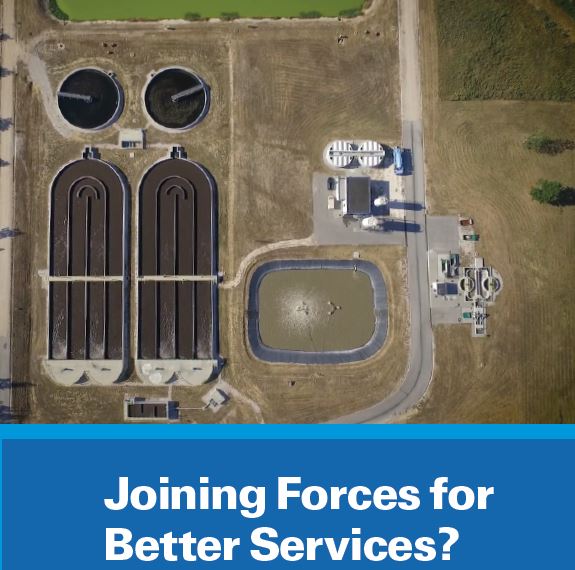Knowledge Brief: Joining Forces for Better Services? When, Why, And How Water and Sanitation Utilities Can Benefit from Working Together
The recently adopted Sustainable Development Goals (SDGs) set an ambitious agenda of providing universal access by 2030 to safely managed water supply and sanitation (WSS) services. Policy makers and sector practitioners know that the SDGs will be achieved only if service providers can provide better services at a lower cost. Yet, in the last decades, policy approaches to structuring service delivery at the right level have been conflicting: some countries have chosen to consolidate service provision centrally, hoping for greater professionalism and economies of scale, whereas others have chosen to decentralize and empower local governments in the hope that more local accountability would provide strong incentives for good services. To reconcile those two apparently contrary trends, an increasing number of countries and local governments are turning, with varying degrees of success, to the aggregation1 of local utility companies. Making utilities work together has been regarded as an opportunity to improve the cost efficiency and performance of service providers, thus making them more sustainable. There is ample empirical evidence in the literature on the existence of economies of scale in the WSS industry, at least up to a certain level. Furthermore, it seems that large utilities tend to operate at a lower unit cost and perform better than smaller ones. For instance, Abbot and Cohen (2009) found that significant economies of scale exist in the WSS industry. More recently, in a study analyzing the performance of WSS utilities in Africa, Van Den Berg and Danilenko (2015) found that size matters in achieving good performance. Two recent analyses based on IB-Net data for utilities in the Danube region (Klien and Michaud 2016) and in the Latin American and the Caribbean Region (Diaz and Flores 2015) showed lower unit costs for larger utility companies. These studies compare utilities serving cities of different sizes. It is not clear when the same scale effects are achieved by grouping a number of noncontiguous providers into a single, larger, provider. Many utility companies and countries embarking on such an aggregation processes have found that those benefits do not always materialize in practice and that the accompanying processes are arduous and fraught with political challenges. A Global Study on the Aggregation of Water Supply and Sanitation Utilities This global study was initiated to provide evidence-based guidance to policy makers and practitioners regarding when, why, and how water and sanitation utilities can work together (“aggregate”) to successfully deliver specific policy outcomes, such as better services or lower costs. This work does not advocate for or against aggregations but rather presents and reviews global evidence, analyzes specific aggregation case studies, and identifies the key characteristics that successful aggregations have in common, depending on their purpose and the context in which they occur. Acknowledging that it is challenging to make “before aggregation” and “after aggregation” cost comparisons because the levels of service are changing, this work focuses on proposing recommendations for successful aggregation, shaping lessons learned into a checklist of key questions to ask, and pointing out key decision points. The recommendations are based on evidence and observed experiences rather than theoretical considerations and sometimes run counter to conventional wisdom on aggregation practices. This study consists of a review of literature and an analysis of both qualitative and quantitative evidence—including a statistical analysis based on IB-Net data covering 1,306 utilities from more than 140 countries; a review of global aggregation trends, collecting data for 111 countries; and 14 case studies from seven countries, providing a deep dive narrative of aggregation experiences. Aggregation Typology Expanding on the work done in World Bank (2005), this report postulates that the design of a successful aggregation should consider both the intended purpose and the context in which it takes place, and characterizes the design of an aggregation as a function of its scope, scale, process, and governance. This report defines a successful aggregation as one in which the aggregated service provider performs significantly better than the previously disaggregated entities with regard to the intended purpose, without unacceptable deterioration of other performance dimensions Understanding Why Success Does Not Always Materialize There can be many reasons why an aggregation is not successful. Despite the potential for economies of scale, one-off or long-term transaction costs can prevent these economies from appearing.2 Aggregation also has possible drawbacks, such as a loss in accountability and political reluctance, that may hamper the process, blocking it before it takes off or damaging it after launch. Clustering service areas increases the distance between the service provider and the end user. Salaries of employees in the agglomerated unit may be adjusted to reflect those of the highest-paying utility, which increases operating costs without necessarily creating equivalent efficiency gains. Lack of political will in aggregation reforms can arise when local authorities perceive such reforms as threats to their sovereignty. Aggregations also make organizations more complex because the numbers of systems, employees, and processes can increase substantially. In addition, utility ownership—in the sense of the allocation of decision and control rights—tends to become more opaque. Instead of a single owner, several municipalities or regional entities share ownership or sign a lease agreement with a utility. Such fragmentation of control and decision rights can produce significant transaction costs. In summary, although serving a larger number of customers has organizational advantages in the production process—which can materialize as economies of scale in lower unit costs or improved performance—greater size also implies higher transaction costs (Coase 1993; Williamson 1975; figure ES.2). This being said, it is important to bear in mind that the outcome of a given aggregation should be measured primarily against its original purpose, which might or might not involve economic efficiency. In some cases, it might be necessary to accept a permanent transaction cost or change in cost structure in return for an important externality; for example, a cross-subsidy between low- and high-cost service areas or an environmental benefit.
